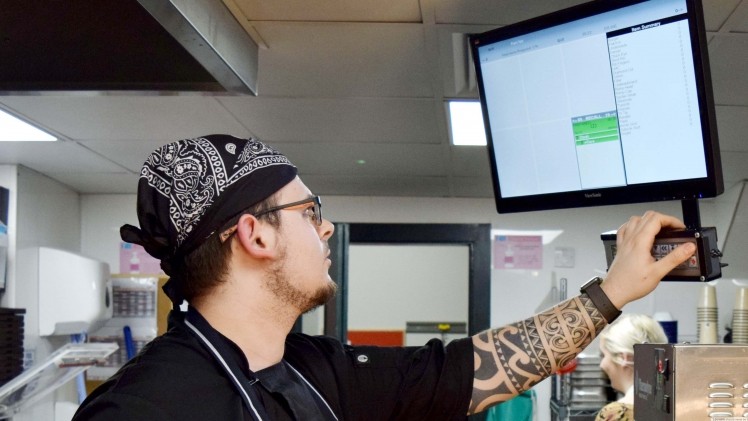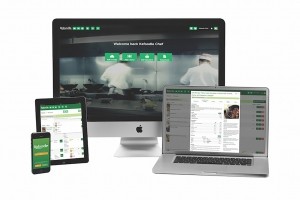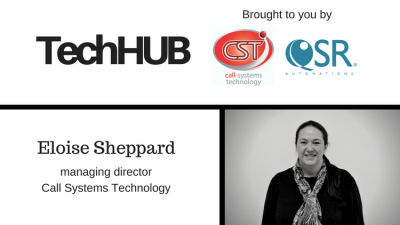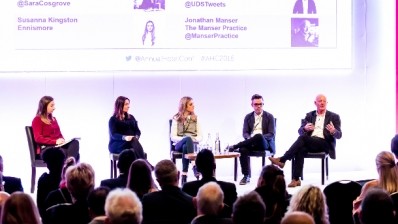Back to front: how tech is building better communications between back and front of house

Traditionally overlooked by tech companies, back-of-house technology is now receiving much more interest as restaurants look to streamline kitchen and back-office operations.
Sophisticated kitchen automation software, systems that make it easier to manage staff and clever databases that manage recipes and ingredients are just a few examples of the behind the- scenes technology that is revolutionising the way modern restaurants are run.
Flat Iron is one of a steadily increasing number of restaurant businesses to utilise advanced automation solutions that bring front and back of house into step with each other. The Charlie Carroll-led group uses QSR Automations ConnectSmart Kitchen (CSK) across back of house and DineTime front of house.
“We were opening a bigger site with two floors and we realised that we needed to rethink the manual printed tickets that we had in the other sites that didn’t allow for front and back of house to communicate, so we investigated and felt that it was the right technology for the Henrietta Street site,” says operations manager Franziska Gach.
The group was keen to increase speed of service and communication.
“In our other sites, it’s very easy for the host to see all of the tables, meaning they can very easily predict wait times and how long a table will stay,” she continues.
“In Henrietta Street, because of the layout, it’s quite difficult and we would have had to have two people constantly communicating with the host. In terms of back of house, operations run smoother.
“We are less likely to lose orders because the physical tickets sometimes got lost. It’s very easy to handle and operate the screens and it makes us run smoother and faster. Speed was definitely a priority, we have quite a lot of people visiting Henrietta Street and we do try to serve them within 10 to 12 minutes.”
Ashley Sheppard, group commercial director at CST, the company that supplies ConnectSmart Kitchen and DineTime, says that one of the biggest issues with restaurant operations today is that so much of the communication is done by mouth or paper, leaving room for unavoidable human error. “Back-of-
house technology such as QSR Automations ConnectSmart Kitchen (CSK), has evolved to such an extent that it allows the kitchen to seamlessly integrate with front of house even more closely and efficiently than ever before,” he says.
“Not only does this mean happier customers, it also ensures a confident workforce who can concentrate on serving customers, rather than checking tickets, chasing orders or organising other team members.”
Deliveroo recently entered the kitchen automation world with the purchase of US kitchen management company Maple. The Deliveroo Toolkit will help restaurants organise and optimise kitchen operations to streamline food preparation, which Deliveroo says will benefit their revenue streams, speed up orders for customers and enable riders to make more deliveries.
The system provides chefs with preparation time information on an item level basis to optimise preparation and cooking speed, prevents bottlen
ecks by providing chefs and managers with a real-time kitchen overview dashboard and also includes purchasing functionality that can predict weekly order quantities.
“This new technology is a game-changer for the food delivery industry, helping restaurants to grow while speeding up service for customers,” says Deliveroo Editions vice-president Rohan
Pradhan.
“Deliveroo prides itself at being at the forefront of innovation, and we’re hugely excited to bring the cutting-edge technology developed by Maple to help enhance our UK operations. We want to think about how we can improve efficiencies in food delivery that will, at the same time, benefit our restaurant partners and
customers’ experience.”
The technology will first be given to all 160 Deliveroo Editions kitchens but will eventually be rolled out worldwide to the delivery company’s 25,000 restaurant partners.
Technology is changing the way dietary requirements are dealt with in restaurants. Kafoodle is billed as an end-to-end food management system that helps improves restaurants’ profitability, digitises their processes and provides “seamless” communication between kitchen and diners.
Its cloud-based software allows teams to share information about menus and update it in real time. Allergens are automatically assigned to ingredients and recipes, allowing restaurants to easily tell diners what each dish contains. Kafoodle can calculate and display the nutritional information of each dish using a simple calculator. Staff can then choose which information they highlight and share with diners, providing a simple means of identifying healthier options.
“I know how resistant staff can be to working with new technology yet at the same time, technology can make things massively easier for kitchen and front-of-house staff,” says Kafoodle co-founder Tarryn Gorre.
“When I developed Kafoodle, I worked from the industry out – consulting widely with the people who would actually be using the product – until I was happy that we had developed technology that was truly simple to use and, above all, really useful.”
The Kafoodle system is used by a number of groups including Salt Yard Group. “We can feel confident now that our allergen menus are accurate and our HACCPs are thorough. At the touch of a button, front of house can check information so we never need to wait for a senior chef to go through menus,” says Salt Yard Group HR director Georgina Laing.
Tech companies are also shaking up the way teams are managed. Planday is a cloud platform that can help employers manage their staff and automate the majority of people-related admin tasks including payroll and rota writing. Planday also allows managers to directly communicate with teams and individual staff. This could include anything from signing off holiday to communicating menu changes across a large group of restaurants. Planday’s customers include Jose Pizarro, Polpo and Sophie’s Steakhouse.
“The biggest issue I had in the past was communication with staff,” says Sam Anstey, who previously helped expand Giraffe globally, and who now leads the team at six-strong restaurant group Laurel Canyon Ventures.
“Planday is almost a social-media app. You have your own picture, details and profile. When we have a new menu, a new offer, a new employee, we send a message to everyone, so we can send attachments, and an introduction straight to their phone.
“In three seconds, I now see 135 people who will get a message on their smartphone. They have to read it before they can see their shift or a schedule. If it’s about safety or important ‘must read’ info like allergens, I can force them to reply before they can use the rest of the app. Restaurant tech has become much easier for people to use over the past few years.”



























